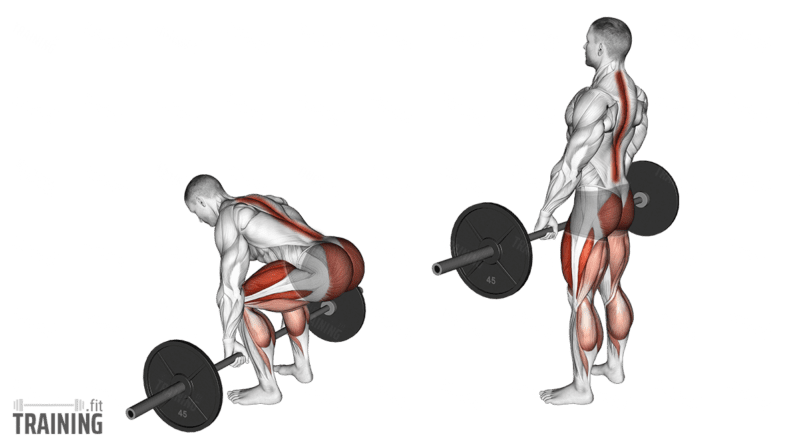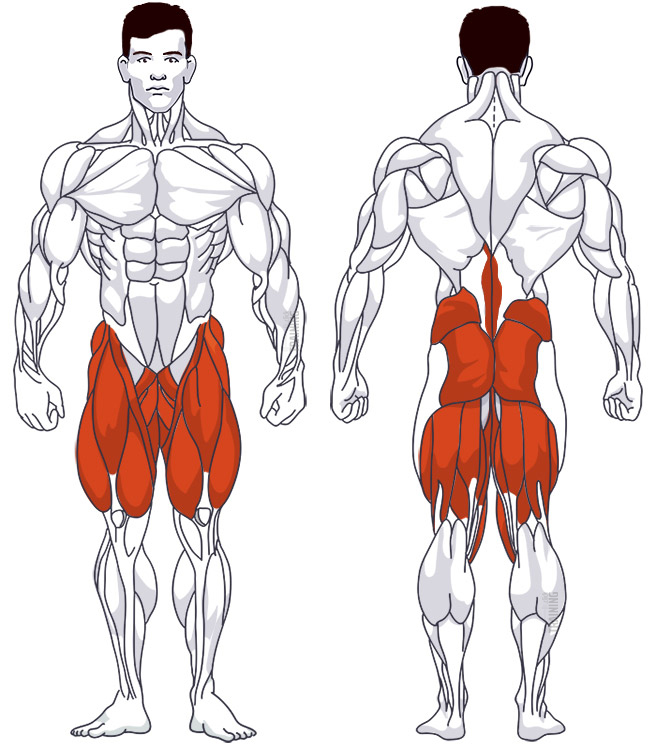Deadlift
Compound exercise, Free weightsThis article is verified by 1 study/publication.
Overview

Main muscles
- Thigh: Quadriceps
(Musculus quadriceps femoris) - Buttocks: Large gluteus maximus
(Musculus gluteus maximus) - Back: Back extensor
(Musculus erector spinae)
Training plans
Here you can find example plans for deadlift training:
Deadlift: Basics and alternatives

Involved main muscle groups:
Deadlift
The deadlift is one of the most well-known, yet often feared and debated exercises in weight training. This is because it’s challenging, and incorrect form can quickly lead to issues, especially with the typically heavy weights used. However, when performed correctly, deadlifts are a vital part of a balanced workout routine.
The movement involves leaning forward and lifting the weight by raising your upper body and extending your bent legs. Deadlifts work numerous muscles in the legs, butt, and back, making it an incredibly powerful compound exercise[1].
Consider other deadlift variations, such as dumbbell deadlift, straight leg deadlift(with dumbbell), or sumo-deadlift. Alternatively, you can try Good Mornings, though proper execution is also demanding. For beginners, back extension and seated back extension on the machine are good options.
Correct execution
Proper form is crucial for safe and effective deadlifts.
If you’re new to the exercise, practice with just the barbell and no added weight. Use a trainer, workout partner, mirrors, or your phone to help perfect your form before lifting heavy weights.
Don’t be discouraged from adding deadlifts to your routine. They’re a key exercise, much like the bench press, squats, or pull-ups.
Video tutorial
Step-by-step instructions
Place the barbell on the floor and stand shoulder-width apart in front of it. Center the bar over your midfoot.
Bend your knees and hips to grab the barbell with an overhand grip, hands shoulder-width apart. Ensure your shoulders are directly above the bar and your hips are level between your head and knees.
Form a slight arch in your lower back and keep the rest of your back straight. Keep your head aligned with your spine and hips. Your back should never arch. Engage your core. You’re now in the starting position.
Lift the weight off the floor with extended arms. Extend your legs and straighten your upper body simultaneously. Lift the barbell in a straight line by keeping it as close to your shins and thighs as possible (without bumping).
Finish the movement by pushing your hips slightly forward, standing upright, and holding the bar in front of your hips. Avoid hyperextending your back. Hold this position for a few seconds.
Lower the bar in a controlled manner by bending your legs and leaning your torso forward, returning to the starting position. Maintain body tension when performing additional repetitions.
Common mistakes and injuries
Don’t lower your butt too much; otherwise, you’ll turn the deadlift into a less effective squat. Your hips should be between your head and knees in the starting position. To find the right posture, position your shoulders directly above the barbell.
The most significant mistake, which can lead to serious injury, is arching your back. Keep your back straight throughout the movement. This usually happens when the weight is too heavy or the hip extension is too weak. The best way to avoid this problem is to focus on your form and reduce the weight. Incorporating additional lower back strengthening exercises into your training can also help until you no longer have issues with the deadlift.
Aim to lift the barbell as vertically as possible. The barbell shouldn’t hit your legs or knees and should not move too far away. The starting and ending positions should be directly above each other.
Also, avoid yanking the weight off the floor. Deadlifting should be done in a controlled manner, like other exercises. Yanking the weight up can worsen your form in the short term and lead to back problems.
At the end of the movement, don’t hyperextend your back. Stand upright with a slight arch in your lower back and keep your upper body straight. Don’t lean back.